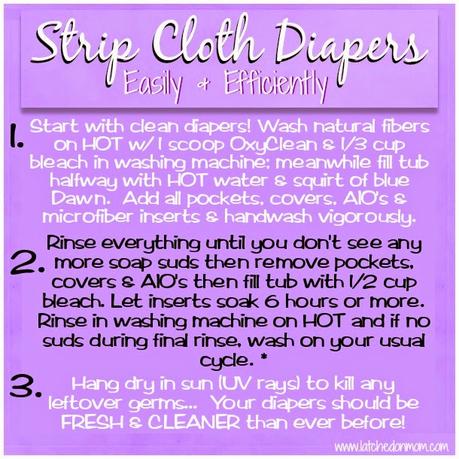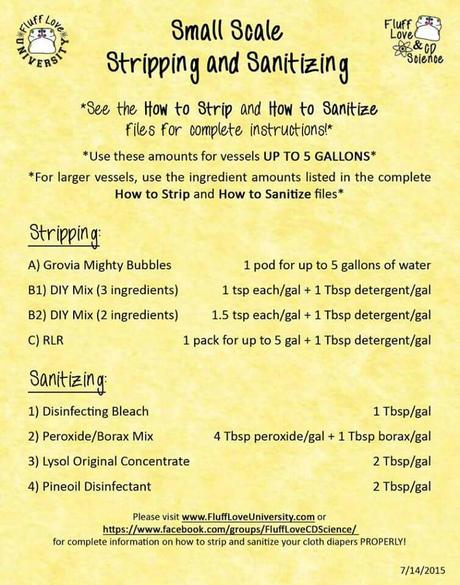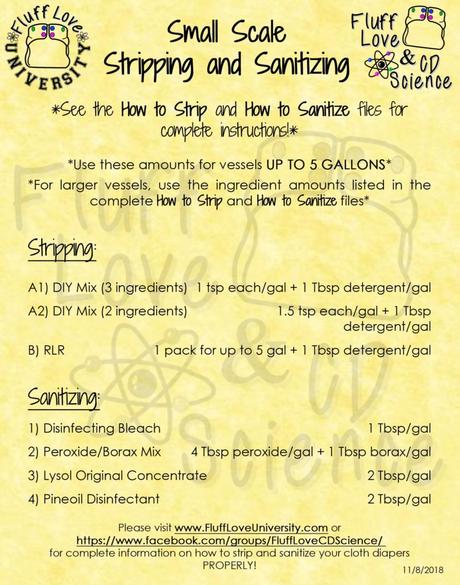To strip cloth diapers, soak them in hot water with a mixture of detergent and bleach. In a large bucket or bathtub, add a small amount of detergent and bleach to hot water and let the diapers soak for several hours.
Cloth diapers are a popular choice for eco-conscious parents looking to save money and reduce waste. While they offer several benefits, over time, they can develop stains, odors, and residue buildup. Stripping cloth diapers is a process that helps remove these issues, leaving your diapers fresh and clean.
We will guide you through the steps to strip cloth diapers properly. By following these instructions, you can ensure your diapers stay absorbent and odor-free, providing optimal comfort for your baby. So, let’s get started with the process of stripping cloth diapers to maintain their quality and performance.
Cloth Diapers
Before we dive into the process of stripping cloth diapers, it’s essential to have a clear understanding of what cloth diapers are and why they are a popular choice for many parents. Cloth diapers have come a long way and are now seen as a modern, eco-friendly alternative to disposable diapers. Not only do they help reduce waste, but they can also save you money in the long run. Cloth diapers are made from various absorbent materials, such as cotton, bamboo, or microfiber, and they come in different styles and sizes to accommodate babies of all ages and sizes.
Different Types Of Cloth Diapers
When it comes to cloth diapers, you have several options to consider. Let’s take a closer look at the different types of cloth diapers available:
- All-in-One (AIO): These diapers have the absorbent layers sewn directly into the outer shell, making them convenient and easy to use. They are similar to disposable diapers in terms of simplicity.
- Pocket diapers: These diapers have a pocket opening, allowing you to insert absorbent inserts or soakers. They offer a customizable level of absorbency and are great for overnight use.
- Prefolds and flats: These diapers consist of a rectangular-shaped cloth that you fold and secure with a fastener or pins. They require a waterproof cover and are a budget-friendly option.
- Hybrids: These diapers combine the features of both cloth and disposable diapers. They have a reusable outer cover and a disposable insert, providing flexibility for different situations.
- Fitted diapers: These diapers are made entirely of absorbent materials and require a separate waterproof cover. They offer excellent leak protection and are ideal for heavy wetters.
Importance Of Stripping Cloth Diapers
Stripping cloth diapers refers to the process of deep cleaning them to remove any buildup of detergent residue, mineral deposits, or bacteria that can affect their absorbency and odor control. Regular washing may not always be sufficient in eliminating these issues, which is why stripping is necessary from time to time.
There are several reasons why stripping cloth diapers is essential:
- Restore absorbency: Over time, cloth diapers can develop a buildup of detergent residue, which can hinder their absorbency. Stripping helps remove this buildup, allowing the diapers to work effectively in keeping your baby dry.
- Eliminate odors: Cloth diapers are subject to odors due to prolonged use. Stripping helps get rid of any lingering smells, leaving your cloth diapers fresh and odor-free.
- Prevent diaper rashes: When cloth diapers are not properly stripped, bacteria can multiply, leading to potential diaper rashes or infections. Stripping helps sanitize the diapers, reducing the risk of such issues.
The different types of cloth diapers available and the importance of stripping them is crucial for maintaining their effectiveness and keeping your baby comfortable. By choosing the right cloth diaper type for your needs and ensuring regular stripping, you can provide your little one with a diapering solution that is not only environmentally friendly but also gentle on their delicate skin.

Credit: www.latchedonmom.com
Preparation For Stripping Cloth Diapers
Before you can start stripping cloth diapers, it’s important to gather all the necessary supplies and properly pre-wash the diapers. By following these steps, you can ensure that your cloth diapers are ready for the stripping process. Let’s take a closer look at each of these preparations.
Gather Necessary Supplies
When it comes to stripping cloth diapers, having the right supplies on hand can make the process much easier and more effective. To get started, make sure you have the following items ready:
- Bleach or a stripping agent: Choose a bleach that is suitable for cloth diapers and doesn’t contain any added fragrances or dyes. Alternatively, you can use a stripping agent specifically designed for cloth diapers.
- Hot water: Hot water is essential for effectively removing any buildup or residue on the diapers. Make sure the water is hot enough to help break down any oils or creams that may be causing issues.
- Large bucket or bathtub: You’ll need a container large enough to hold all the diapers you plan to strip.
- Gloves: Protect your hands from any harsh chemicals by wearing gloves throughout the process.
- Soft brush or old toothbrush: For stubborn stains or residue, a soft brush or an old toothbrush can help you scrub them away.
- Drying rack or clothesline: After stripping the diapers, you’ll need a place to hang them up to air dry.
Pre-wash The Diapers
Ensure that your cloth diapers are pre-washed properly before you begin the stripping process. This will help remove any loose debris or surface dirt, allowing the stripping agents to work more effectively. Follow these steps to pre-wash your cloth diapers:
- Separate the diapers from the inserts or liners, if applicable.
- Give the diapers a quick rinse in cold water to remove any solid waste.
- Once rinsed, wash the diapers in hot water with a suitable detergent. Avoid using fabric softeners or any additives that can interfere with the stripping process.
- After the wash cycle, rinse the diapers again to ensure all detergent is fully removed.
- Squeeze out any excess water from the diapers, but don’t wring them out.
- If necessary, hang the diapers up to air dry or place them in a dryer on a low heat setting.
Now that you’ve gathered the necessary supplies and pre-washed the diapers, you’re ready to move on to the next step of actually stripping the cloth diapers. Stay tuned for our upcoming blog post on the stripping process itself!
Methods For Stripping Cloth Diapers
Stripping cloth diapers is an essential step in maintaining their absorbency and effectiveness. Over time, cloth diapers can accumulate residue from detergent buildup, hard water minerals, and bacteria, which can impair their performance. Fortunately, there are several effective methods for stripping cloth diapers. In this article, we will explore three popular methods for stripping cloth diapers: the Hot Water Soak Method, Vinegar Soak Method, and Bleach Soak Method.
Hot Water Soak Method
The Hot Water Soak Method is a simple and effective way to strip cloth diapers. To start, fill a clean bathtub or large basin with hot water. Make sure the water is not too hot that it could damage the diapers or your hands. Next, add a mild detergent that is free of additives, fragrances, and fabric softeners. Allow the diapers to soak for about 30-60 minutes, ensuring that they are fully submerged in the water. After the soaking time, thoroughly rinse the diapers to remove any remaining detergent. Finally, squeeze out the excess water and hang the diapers to dry.
Vinegar Soak Method
The Vinegar Soak Method is another effective way to strip cloth diapers and remove stubborn residue. To begin, fill a clean bathtub or large basin with warm water. Add one cup of distilled white vinegar for every gallon of water used. Place the diapers in the mixture, making sure they are fully immersed. Allow the diapers to soak for at least one hour, but overnight soaking is recommended for more heavily soiled diapers. After the soaking time, rinse the diapers thoroughly to remove the vinegar smell. Finally, squeeze out the excess water and hang the diapers to dry.
Bleach Soak Method
The Bleach Soak Method is a more powerful option for stripping cloth diapers but should be used sparingly. Start by filling a clean bathtub or large basin with warm water. Add 1/4 cup of bleach for every gallon of water used. Place the diapers in the bleach solution, ensuring they are fully submerged. Allow the diapers to soak for about 30 minutes, keeping in mind that bleach can break down fabrics over time. After the soaking time, thoroughly rinse the diapers to remove any bleach residue. It is essential to neutralize bleach by adding an additional rinse cycle after soaking. Finally, squeeze out the excess water and hang the diapers to dry.

Credit: www.pinterest.com
Step-by-step Guide To Stripping Cloth Diapers
Cloth diapers are a cost-effective and eco-friendly choice for many parents. However, over time, they can develop a buildup of residue from detergent, hard water, or diaper creams, affecting their absorbency and causing unpleasant odors. Stripping cloth diapers is a process that helps remove these residues, restoring their performance and freshness. In this step-by-step guide, we will walk you through the process of stripping cloth diapers effectively.
Step 1: Choose A Stripping Method
The first step in stripping cloth diapers is to choose the method that suits your preferences and supplies. There are different options to consider, such as:
- Boiling: This method involves boiling the diapers in a large pot of water to remove residues. It is important to note that boiling may not be suitable for all types of cloth diapers, so check your manufacturer’s guidelines before proceeding.
- Vinegar Soak: Vinegar is known for its natural cleaning properties. Fill a bathtub or large container with water and add one cup of white vinegar. Soak the diapers for about 30 minutes to break down the buildup.
- Dawn Dish Soap: Dawn dish soap is an excellent option for stripping cloth diapers. Fill a bathtub or sink with hot water and add a small amount of Dawn dish soap. Let the diapers soak for about an hour.
Step 2: Prepare The Stripping Solution
Once you have chosen your preferred stripping method, the next step is to prepare the solution. Follow these instructions for each method:
BoilingFill a large pot with enough water to cover the diapers. Bring the water to a boil. You can add a small amount of detergent for extra cleansing power, but it’s not necessary. Place the diapers in the boiling water and let them simmer for 10-15 minutes. Stir occasionally to ensure all areas are evenly cleaned. Carefully remove the diapers and allow them to cool before moving on to the next step.
Vinegar SoakFill a bathtub or large container with warm water. Add one cup of white vinegar and mix well. Place the diapers in the solution, making sure they are fully submerged. Let them soak for about 30 minutes, stirring occasionally to loosen any residue. After the soak, squeeze out any excess liquid and proceed to the next step.
Dawn Dish SoapFill a bathtub or sink with hot water. Add a small amount of Dawn dish soap and mix gently to create suds. Place the diapers in the soapy water, ensuring they are completely immersed. Allow them to soak for about an hour, occasionally agitating the water to help remove any buildup. Once the soaking time is complete, move on to the rinsing step.
Step 3: Soak The Diapers
Once your stripping solution is ready, it’s time to soak the diapers. Follow these steps:
- Boiling: Carefully place the pre-boiled diapers in a sink or large container filled with cold water to cool them down. Let them sit for a few minutes before moving on to the next step.
- Vinegar Soak: After the 30-minute soak in the vinegar solution, gently squeeze out any excess liquid from the diapers.
- Dawn Dish Soap: Drain the soapy water from the bathtub or sink and gently squeeze the excess liquid out of the diapers.
Step 4: Rinse And Wash The Diapers
The final step in stripping cloth diapers is to rinse and wash them thoroughly. Follow these guidelines:
- Boiling: Rinse the boiled diapers with cold water to remove any soap residue. Once rinsed, proceed to wash them according to your regular diaper washing routine.
- Vinegar Soak: Rinse the vinegar-soaked diapers with warm water. You can follow up with a regular wash cycle using a recommended cloth diaper detergent.
- Dawn Dish Soap: Rinse the diapers with warm water to remove any remaining soap residue. It’s essential to rinse them thoroughly, ensuring no soap is left behind. After rinsing, launder the diapers as you would normally.
Congratulations! You have successfully stripped your cloth diapers, removing buildup and residues that may have been affecting their performance. Remember to follow the manufacturer’s care instructions and check for any specific recommendations regarding stripping. Enjoy the fresh and absorbent cloth diapers!
Tips And Recommendations
Stripping cloth diapers is an important process that helps to keep them clean, fresh, and absorbent. By removing the buildup of detergent, minerals, and any residue that may accumulate over time, you can ensure that your cloth diapers are performing at their best. In this section, we will discuss some tips and recommendations on how to effectively strip cloth diapers.
Frequency Of Stripping
Knowing when to strip your cloth diapers is essential for their proper maintenance. It is generally recommended to strip your diapers every 4-6 weeks, or whenever you notice that they are no longer performing as well as they used to. This can be indicated by leaks, odors, or reduced absorbency. However, it is important to note that every diapering routine is unique, so you may need to adjust the frequency based on your specific needs.
Avoiding Buildup In Cloth Diapers
Prevention is key when it comes to avoiding buildup in cloth diapers. By following a few simple steps, you can minimize the risk of detergent residue or mineral deposits accumulating over time:
- Use an appropriate amount of detergent: Too much detergent can leave behind residue, and too little may not effectively clean your diapers. Follow the manufacturer’s guidelines or use a cloth diaper detergent specifically designed for this purpose.
- Choose the right water temperature: Hot water is generally recommended for effective cleaning, but be cautious if your diapers have special care instructions. Always check the label or manufacturer’s recommendations.
- Rinse thoroughly: Make sure to rinse your diapers well after each use to remove any lingering detergent or waste. Residue left in the diapers can lead to buildup over time.
- Consider your water hardness: Hard water can contribute to mineral buildup on your diapers. If you live in an area with hard water, you may need to adjust your washing routine accordingly. Using a water softener or adding a water conditioner can be beneficial.
Importance Of Correct Washing Routine
Having a consistent and correct washing routine is crucial for maintaining the performance and longevity of your cloth diapers. Here are some key tips to ensure you are taking proper care of your diapers:
- Pre-wash: Start by doing a quick pre-wash cycle to remove any excess waste and prepare the diapers for the main wash.
- Main wash: Use a detergent appropriate for cloth diapers and follow the recommended amount for your load size. Select a proper wash cycle to thoroughly clean your diapers.
- Extra rinses: Consider adding extra rinse cycles to ensure all detergent residue is removed. This step helps in preventing buildup and keeps your diapers fresh and odor-free.
- Drying: To prolong the lifespan of your cloth diapers, air-drying or using a low heat setting in the dryer is recommended. Avoid high heat as it can damage the fabric.
By following these tips and recommendations, you can maintain clean and hygienic cloth diapers for your little one. Remember, a proper washing routine and regular stripping will keep your diapers performing their best and provide comfort and convenience for your baby.

Credit: fluffloveuniversity.com
Frequently Asked Questions For How To Strip Cloth Diapers?
How To Strip Cloth Diapers?
To strip cloth diapers, soak them in a mixture of hot water and vinegar, then rinse thoroughly. Repeat if necessary.
Can You Strip Cloth Diapers In The Washing Machine?
Yes, you can strip cloth diapers in the washing machine by adding vinegar or baking soda during a hot wash cycle.
How Often Should I Strip My Cloth Diapers?
You should strip cloth diapers every 3-6 months or when they start to develop odor or repel liquid.
Is Stripping Cloth Diapers Necessary?
Stripping cloth diapers is necessary to remove detergent buildup, eliminate odors, and restore their absorbency.
Will Stripping Cloth Diapers Damage Them?
No, when done correctly, stripping cloth diapers will not damage them. It actually helps prolong their lifespan and effectiveness.
Conclusion
To sum up, stripping cloth diapers is an essential step in maintaining their absorbency and overall effectiveness. By following the proper technique and using the right products, you can easily remove build-up, stains, and odors from your diapers. Remember to test any new stripping method on a small patch first to ensure compatibility with your specific diaper materials.
Regularly stripping your cloth diapers will help prolong their lifespan and provide your little one with a comfortable and hygienic diapering experience.
